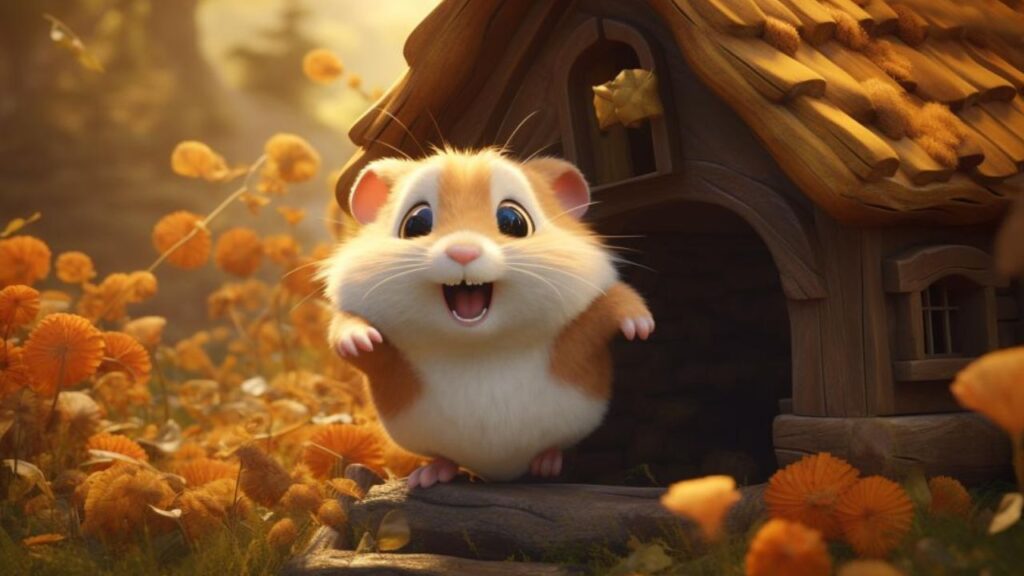When it comes to keeping a hamster happy, playtime is just as essential as a sunny day is to a flourishing garden. Much like how your favorite flowers need sunlight to grow, your little furball needs playful interaction to thrive. Whether they’re darting through tunnels, nibbling on puzzle feeders, or simply scampering about, play is a critical part of your hamster’s daily routine. It not only keeps them entertained but also contributes to their overall well-being. Let’s dive into why play is so important and how interactive toys can elevate your hamster’s quality of life.
Opening Hook: Play – The Sunshine in Your Hamster’s Life
Imagine your hamster’s cage as a garden. Without the right conditions—proper food, clean water, and plenty of interaction—your little friend can’t bloom. Just as flowers rely on sunlight, hamsters rely on play to grow and stay healthy. A hamster that’s denied the opportunity to play may start to wilt, becoming lethargic or even developing unhealthy behaviors. But when play is part of their everyday life, they’re bright, active, and full of curiosity.
Think about it: Have you ever noticed your hamster doing a little “popcorn jump” or frantically burrowing when you introduce something new to their environment? That’s them expressing joy, a pure reflection of their instinctual need for play. Just like you might savor a walk in the park or a good book, your hamster thrives on activities that stimulate both their body and mind.
The Role of Play in Hamster Well-being
Now, let’s dig a bit deeper—why is play so vital to your hamster’s health? Playtime isn’t just about burning off energy (though it certainly helps!). It’s about mental enrichment too. Scientists have long studied the effects of environmental enrichment on animals, and the results are clear: animals with enriched environments, which include toys and activities, tend to be healthier, live longer, and exhibit fewer stress-related behaviors.
For hamsters, play is a natural outlet for their instincts. In the wild, hamsters spend their days foraging, tunneling, and exploring. When we bring them into our homes, they still have those same needs. Without adequate stimulation, a hamster can become bored, which might lead to chewing on cage bars, pacing, or other signs of distress. On the flip side, a well-entertained hamster is more likely to be curious, active, and content—traits we all love to see in our little companions.
Research on animal enrichment emphasizes the benefits of varied, engaging environments, noting that these settings not only reduce stress but also promote natural behaviors. For hamsters, this means that the right kind of play can significantly boost their mental and physical health, making them more resilient and happier overall.
Introducing Interactive Toys
Now, let’s talk about one of the best ways to ensure your hamster gets the playtime they need: interactive toys. If you’ve ever handed a child a new toy and watched their eyes light up, you’ve seen firsthand the joy of discovery. Hamsters experience a similar excitement when they encounter a new, engaging toy. But what exactly are interactive toys?
Interactive toys are specifically designed to engage your hamster’s natural instincts—whether it’s foraging, climbing, or burrowing. These toys aren’t just static objects; they require your hamster to think, explore, and sometimes even problem-solve to get a reward. For instance, a puzzle feeder might require your hamster to figure out how to access hidden treats, while a tunnel system could encourage them to explore new routes and spaces.
Why are these toys a game-changer in hamster care? Because they provide mental stimulation alongside physical activity. A hamster with interactive toys is not just moving around—they’re thinking, exploring, and engaging with their environment in a way that closely mimics their natural behaviors. This keeps them happy, healthy, and far less likely to develop those pesky boredom habits we mentioned earlier.
In the following sections, we’ll explore how to choose the right toys for your hamster, introduce them in a way that’s both safe and exciting, and create a play routine that ensures your furry friend stays entertained and engaged. So, let’s get ready to take your hamster’s playtime to the next level!
Understanding Your Hamster’s Play Preferences

Every hamster is a unique little character, with their own quirks, preferences, and play styles. Understanding what makes your hamster tick can make all the difference in selecting the right toys and creating an environment that truly enriches their life. Just like how some kids prefer building with blocks while others love to run around, hamsters have distinct play preferences that reflect their natural instincts. Let’s delve into what play means for your hamster, how you can observe their habits to decode their preferences, and how to tailor toys to fit their individual personality.
What Does Play Mean to a Hamster?
Playtime for a hamster isn’t just about fun and games—it’s a way for them to express their natural behaviors and instincts. In the wild, hamsters are busy little creatures, constantly foraging for food, burrowing for safety, and exploring their surroundings. These activities are crucial for their survival, and even in captivity, these instincts remain strong.
- Burrowing: One of the most fundamental hamster behaviors is burrowing. Hamsters dig to create cozy nests, hide from predators, and store food. When your hamster kicks up bedding or digs into their substrate, they’re not just being playful—they’re acting out an age-old survival instinct. Providing opportunities for burrowing, whether through deep bedding or tunnels, taps into this natural behavior and gives them a sense of security.
- Foraging: In the wild, hamsters spend a significant amount of time searching for food. Foraging isn’t just about eating; it’s also a mentally stimulating activity that keeps their brains sharp. By hiding treats in puzzle feeders or scattering food around their cage, you can encourage your hamster to engage in this instinctual behavior, turning mealtime into an enriching experience.
- Exploring: Hamsters are naturally curious creatures. They love to explore new environments, crawl through tunnels, and climb up interesting structures. This curiosity is part of their instinct to search for food, find nesting sites, and avoid danger. Providing a variety of toys and changing their environment regularly can satisfy this exploratory urge and prevent boredom.
Observing Your Hamster’s Habits
So, how do you figure out which activities your hamster enjoys the most? The key is observation. By spending time watching your hamster, especially during their most active periods (usually in the evening or at night), you can pick up on the behaviors they gravitate toward.
For example, one hamster owner I know noticed that her hamster, Nibbles, spent a lot of time trying to dig into the corners of his cage, even though the bedding wasn’t particularly deep. She decided to add a digging box filled with sand, and Nibbles couldn’t have been happier. He spent hours each night digging, rolling, and playing in the sand—his natural instincts fully engaged.
You can do the same with your hamster. Take note of what they do when they’re awake and active:
- Does your hamster constantly dig at the bedding? They might appreciate deeper substrate or a designated digging box.
- Are they always gnawing on things? They could be looking for something to chew on, like a wood block or a treat stick.
- Do they try to climb the sides of their cage? They might enjoy climbing toys or a multi-level cage with plenty of vertical space.
By observing these habits, you can tailor their environment to better suit their natural tendencies, making their playtime both enjoyable and fulfilling.
Tailoring Toys to Your Hamster’s Personality
Once you’ve got a good sense of your hamster’s play habits, it’s time to match those behaviors with the right toys. Not all hamsters are the same, and what works for one might not work for another. This is where your understanding of your hamster’s personality comes into play.
- The Digger: If your hamster loves to dig, consider providing them with toys and setups that cater to this need. A digging box filled with sand or a deeper layer of bedding in their cage can offer hours of entertainment. You can even bury treats or toys in the bedding for them to discover—a little treasure hunt that mimics natural foraging behavior.
- The Forager: For hamsters that are always on the lookout for food, puzzle feeders or treat-dispensing toys are ideal. These toys challenge them to use their brain to figure out how to get to the goodies inside, offering mental stimulation along with the physical activity of moving and manipulating the toy.
- The Climber: If your hamster is a bit of an acrobat, consider adding climbing toys or platforms to their cage. Items like ladders, ropes, and multi-level structures can satisfy their need to climb and explore different heights. Just make sure these toys are sturdy and safe, with no risk of falls or injuries.
- The Explorer: Some hamsters are natural adventurers, always looking for new places to explore. For these curious critters, tunnels, hideouts, and even hamster balls can provide endless entertainment. Changing up the layout of their toys and cage accessories regularly can also keep things fresh and exciting for them.
Scientific studies on animal behavior support the idea that tailored enrichment—providing animals with toys and activities that match their natural behaviors—leads to happier, healthier pets. By understanding your hamster’s play preferences and choosing toys that align with their instincts, you’re not just giving them something to do—you’re enriching their life in a meaningful way.
Selecting the Right Interactive Toys

Choosing the perfect interactive toys for your hamster is akin to picking out the best tools for a craftsman—it’s all about finding the right fit that will stimulate their natural behaviors and keep them happily engaged. Interactive toys aren’t just any toys; they’re specifically designed to challenge your hamster’s mind and body, providing not just entertainment but also critical mental and physical enrichment. Let’s explore the science behind why these toys are so effective, examine the various types of interactive toys available, and cover essential safety tips to ensure your hamster has a fun and secure playtime.
The Science Behind Interactive Toys
Interactive toys are more than just fancy gadgets—they’re rooted in the principles of cognitive stimulation and environmental enrichment. Research in the field of animal behavior has shown that when small animals, like hamsters, are provided with toys that engage their minds, they exhibit reduced stress levels, enhanced problem-solving skills, and overall better health.
Studies on rodents, including hamsters, have demonstrated that cognitive stimulation through interactive toys can lead to the development of new neural connections in the brain. This is similar to how learning new skills can keep the human brain sharp. In an enriched environment where a hamster has access to toys that challenge them to think, solve problems, or physically engage in activities, their brain remains active and healthy. For example, a study published in the journal Behavioural Brain Research found that rodents provided with complex environments, including toys and tunnels, showed improved cognitive functions and reduced signs of anxiety.
Interactive toys also mimic the challenges a hamster would face in the wild, such as foraging for food or navigating through tight spaces. By providing these types of challenges in a controlled environment, you help satisfy your hamster’s instinctual needs, which leads to a happier and more fulfilled pet. In essence, interactive toys aren’t just fun—they’re a critical part of your hamster’s mental and physical well-being.
Types of Interactive Toys
When it comes to choosing interactive toys for your hamster, the options are vast, each catering to different aspects of a hamster’s natural behavior. Here’s a breakdown of some of the most popular categories of interactive toys and how they benefit your hamster:
- Puzzle Feeders: These are toys that require your hamster to work to access their food or treats. Puzzle feeders can range from simple treat balls that dispense food as they roll, to more complex mazes that your hamster must navigate to find their reward. Puzzle feeders are excellent for mental stimulation, as they encourage problem-solving and mimic the natural foraging behavior of hamsters. They also help slow down eating, which can be beneficial for hamsters prone to overeating.
- Tunnels and Tubes: Hamsters are natural burrowers, and tunnels provide them with the perfect outlet for this instinct. Tunnels and tubes can be simple, straight paths or more complex systems with multiple branches and levels. They satisfy your hamster’s urge to dig and explore, while also providing them with a sense of security as they navigate through enclosed spaces. Some tunnels are made from flexible materials, allowing you to change the configuration regularly to keep things interesting for your hamster.
- Climbing Structures: For the adventurous hamsters that love to climb, multi-level climbing structures, ladders, and ropes offer a great way to burn off energy and stay active. Climbing is not only physically stimulating but also mentally engaging, as your hamster has to figure out the best routes and manage their balance. Climbing structures can also help prevent boredom by adding vertical space to your hamster’s environment, making their cage feel larger and more complex.
- Chew Toys: While not traditionally considered “interactive,” chew toys are essential for hamsters, as they help keep their ever-growing teeth in check. Interactive chew toys, like those that double as foraging toys, add an extra layer of engagement. For instance, a wooden block with hidden treats inside not only satisfies your hamster’s need to chew but also encourages problem-solving.
- Rolling Balls and Hamster Balls: Although hamster balls should be used with caution (as they can be stressful for some hamsters), they do offer an interactive way for your hamster to explore a larger area. Rolling balls that dispense treats as they move can also be a fun way for your hamster to get exercise while engaging in a game of “chase.”
Safety First
While it’s exciting to introduce new toys to your hamster’s environment, safety should always be your top priority. Here are some crucial safety tips to keep in mind when selecting and using interactive toys:
- Avoid Small Parts: Hamsters are notorious for chewing on anything they can get their teeth on. Any toy with small parts or pieces that could break off easily poses a choking hazard. Ensure all toys are made of sturdy, durable materials that can withstand gnawing without splintering or breaking.
- Non-Toxic Materials: Always check that the toys are made from non-toxic materials. Some plastics or paints can be harmful if ingested. Look for toys labeled as safe for pets, and whenever possible, opt for natural materials like untreated wood or paper.
- Size Matters: Make sure the toys are appropriately sized for your hamster. A tunnel that’s too small could lead to your hamster getting stuck, while a puzzle feeder that’s too large might be impossible for them to use effectively. Always choose toys that match your hamster’s size and abilities.
- Supervise New Toys: When introducing a new toy, supervise your hamster’s first few interactions with it. This way, you can ensure that they’re using it safely and not trying to eat parts of it that aren’t meant to be ingested. It also allows you to gauge whether the toy is a good fit for your hamster’s personality and play style.
- Regular Inspections: Over time, toys can wear down, become damaged, or develop sharp edges. Regularly inspect your hamster’s toys for signs of wear and tear, and replace them if they’re no longer safe. This not only keeps your hamster safe but also ensures they always have engaging and functional toys to play with.
By carefully selecting and maintaining interactive toys, you provide your hamster with a safe and enriching environment that caters to their natural instincts and keeps them both mentally and physically active. A well-chosen toy isn’t just a plaything—it’s a tool for enhancing your hamster’s quality of life, making them happier, healthier, and more content in their little world.
Introducing Your Hamster to New Toys

Bringing a new toy into your hamster’s life can be a bit like introducing a child to a new friend—there’s excitement, curiosity, and sometimes a little hesitation. To ensure that your hamster’s first encounter with a new toy is a positive one, it’s essential to introduce the toy in a way that doesn’t overwhelm or scare them. Just like any new experience, a gentle and thoughtful approach will help your hamster feel comfortable and more likely to engage with their new plaything. In this section, we’ll explore how to make those first impressions count, the benefits of positive reinforcement, and how to monitor your hamster’s interaction with their new toy to ensure it’s a hit.
First Impressions Matter
Hamsters are creatures of habit and can be quite cautious when faced with something unfamiliar. A new toy, especially one that’s large or makes noise, can initially be intimidating for them. That’s why it’s important to introduce new toys gradually, allowing your hamster to get used to the new addition to their environment at their own pace.
Start by placing the new toy near their cage or in an area where they spend a lot of time, but outside of their immediate space. This allows your hamster to see and smell the toy without feeling like it’s invading their territory. Let the toy sit there for a day or two, so your hamster can grow accustomed to its presence. You might notice your hamster sniffing the toy or cautiously approaching it—this is a good sign that they’re getting used to it.
Once your hamster seems comfortable with the toy being nearby, you can move it into their cage or play area. Place it somewhere accessible but not right in the center of their space; you want them to be able to approach the toy on their own terms. At this stage, avoid pushing the toy toward them or forcing them to interact with it. Hamsters need time to explore and investigate new objects, and rushing this process can lead to stress or fear.
One of the best ways to help your hamster warm up to a new toy is by associating it with something positive. This is where positive reinforcement comes in.
The Power of Positive Reinforcement
Positive reinforcement is a powerful tool in animal training and behavior modification. It involves rewarding desired behaviors with something the animal finds pleasurable, such as a treat or verbal praise. In the case of hamsters, who are food-motivated creatures, using treats to encourage interaction with a new toy can be particularly effective.
Once your hamster has had a chance to explore the new toy on their own, you can begin to use positive reinforcement to encourage them to engage with it more actively. Start by placing a small treat, like a sunflower seed or a piece of dried fruit, near or on the toy. When your hamster approaches the toy to retrieve the treat, they’re likely to start interacting with the toy itself—maybe pushing it with their nose, climbing on it, or gnawing at it. Every time they do this, offer gentle verbal encouragement in a calm, soothing voice. Over time, your hamster will begin to associate the toy with these positive experiences.
If the toy is something like a puzzle feeder, you can show your hamster how it works by placing a treat inside and letting them see you do it. They might not figure it out right away, but with gentle encouragement and a bit of patience, they’ll soon learn that the toy is both fun and rewarding. The key is to let your hamster discover and engage with the toy at their own pace, while consistently rewarding their efforts.
Scientific studies on positive reinforcement in small animals have shown that this method not only encourages desired behaviors but also reduces stress and builds trust between the animal and their owner. By using positive reinforcement to introduce new toys, you’re helping your hamster feel safe and confident in their environment, which in turn makes them more likely to enjoy and benefit from their toys.
Monitoring and Adjusting
Introducing a new toy doesn’t end once your hamster starts interacting with it. It’s important to monitor how they use the toy and to be attentive to any signs that they’re not engaging with it as expected. Every hamster is different, and while one might immediately take to a new toy, another might show little interest or even seem wary of it.
Watch for the following signs to gauge your hamster’s reaction:
- Active Engagement: Your hamster is playing with the toy regularly, using it as intended (e.g., chewing on a chew toy, running through a tunnel, solving a puzzle feeder). This is a clear sign that the toy is a hit!
- Curiosity Followed by Disinterest: Your hamster might initially investigate the toy but then lose interest. This could mean the toy isn’t stimulating enough or doesn’t cater to their play preferences. In this case, try introducing a different type of toy or changing the location or context in which the toy is used.
- Avoidance: If your hamster avoids the toy entirely, it might be too intimidating, or they might not understand how to use it. You can try making the toy more appealing by adding treats or placing it in a different part of the cage. If avoidance continues, it might be best to remove the toy and try something else.
If your hamster seems indifferent or even afraid of a new toy, don’t be discouraged. Sometimes, it just takes a little time for them to warm up to something new, or you might need to try a different approach. For instance, if a toy is too complex, consider simplifying it by removing some parts or starting with an easier version. Alternatively, if the toy doesn’t seem challenging enough, you could introduce a more advanced toy that better suits their skills.
Finally, keep in mind that hamsters, like all animals, can get bored with even the best toys. Rotating toys in and out of their environment every few weeks can help keep their interest alive. You can also vary the types of toys you offer, switching between puzzle feeders, tunnels, chew toys, and climbing structures to keep things fresh and exciting.
Hannah’s Training Tactics: Quick Tips for Interactive Toy Success

When it comes to ensuring your hamster enjoys their toys, a little strategy goes a long way. Introducing interactive toys into your hamster’s life can be a rewarding experience, but it’s important to approach it thoughtfully to maximize both safety and fun. Here are some quick, actionable tips to help you make the most of your hamster’s playtime. These simple strategies can make all the difference in how your hamster engages with their toys, leading to a happier and more stimulated little companion.
Tip 1: Start with Simple Toys and Gradually Introduce More Complex Ones
When you first start introducing toys to your hamster, it’s best to keep it simple. Think of it like teaching a child to ride a bike—you wouldn’t start with a mountain bike on a steep trail. Instead, you’d begin with training wheels on flat ground. The same principle applies to your hamster.
Why Start Simple? Starting with simple toys allows your hamster to build confidence and become familiar with the concept of play. For example, a straightforward wooden chew toy or a basic tunnel can be a great starting point. These toys are easy for your hamster to understand and use, which helps them feel comfortable and encourages them to explore further.
As your hamster becomes more comfortable with their toys, you can gradually introduce more complex options. For instance, once they’ve mastered a basic chew toy, you might introduce a puzzle feeder that requires a bit of problem-solving to access the treats inside. This gradual progression not only keeps your hamster engaged but also helps prevent them from becoming overwhelmed or frustrated by toys that are too advanced for their current level of understanding.
How to Implement This Tip:
- Start with Basic Toys: Introduce one or two simple toys at a time, such as a wooden block for chewing or a straightforward cardboard tube for crawling through.
- Observe and Evaluate: Watch how your hamster interacts with these toys. Once they’re regularly engaging with them, it’s a sign they’re ready for something a bit more challenging.
- Level Up Gradually: Introduce more complex toys, such as a puzzle feeder or a multi-level climbing structure, one at a time. Give your hamster plenty of time to explore and get used to each new toy before introducing another.
By starting simple and gradually increasing the complexity of your hamster’s toys, you’re helping them build skills and confidence at a pace that’s comfortable for them.
Tip 2: Always Supervise the First Few Play Sessions with a New Toy to Ensure It’s Safe and Enjoyable for Your Hamster
Even if a toy looks safe, it’s important to supervise your hamster’s initial play sessions with it. Hamsters are curious creatures, and sometimes that curiosity can lead them into situations that aren’t safe. Supervision during the first few play sessions ensures that the toy is as safe and fun as you intended it to be.
Why Supervision is Key: While manufacturers often test pet toys for safety, every hamster is unique, and what’s safe for one might not be for another. By keeping a close eye on your hamster as they explore a new toy, you can catch any potential issues early—whether it’s a part that’s too small and could be swallowed, a material that your hamster is trying to gnaw off in dangerous chunks, or a tunnel that might be a bit too tight.
Additionally, supervision allows you to gauge your hamster’s reaction to the toy. Are they excited and curious, or do they seem scared or stressed? Your presence can provide reassurance if they’re hesitant, and you can quickly step in if anything seems off.
How to Implement This Tip:
- Create a Safe Space: Place the new toy in an area where you can easily monitor your hamster, such as in their playpen or during out-of-cage playtime.
- Watch Closely: Observe how your hamster interacts with the toy. Look for signs of distress, like excessive chewing on parts that could be harmful, getting stuck in tight spaces, or ignoring the toy altogether.
- Intervene if Necessary: If you notice any safety concerns, remove the toy immediately. Adjust it if possible, or consider replacing it with a different one. If your hamster is ignoring the toy, try adding a treat to encourage interaction or removing the toy and reintroducing it later.
- Repeat with New Toys: Continue this process with each new toy to ensure every playtime is safe and enjoyable.
Supervision during the first few play sessions can help prevent accidents and ensure your hamster has a positive experience with their new toys.
Tip 3: Keep a “Toy Box” and Rotate Toys Weekly to Keep Playtime Fresh and Exciting
Just like kids with their favorite toys, hamsters can get bored if they’re playing with the same things day in and day out. To keep things exciting, consider creating a “toy box” and rotating the toys in and out of your hamster’s environment on a regular basis. This simple strategy can make old toys feel new again and keep your hamster engaged.
Why Rotation Works: Hamsters are naturally curious and love to explore new things. When you rotate their toys, you’re continually providing new stimuli that challenge their brains and prevent boredom. Even a toy they’ve played with before can feel fresh and interesting if they haven’t seen it in a while.
Rotating toys also allows you to match your hamster’s playthings with their current interests or energy levels. For example, if your hamster is particularly active one week, you might want to bring out more climbing toys or tunnels. If they seem more interested in food, it might be a good time to reintroduce a puzzle feeder.
How to Implement This Tip:
- Create a Toy Box: Designate a box or container to store your hamster’s toys when they’re not in use. This could be anything from a small plastic bin to a drawer dedicated to hamster supplies.
- Rotate Weekly: Each week, choose a selection of toys from the box to place in your hamster’s cage or play area. Rotate different types of toys—such as tunnels, chew toys, and puzzle feeders—to keep the environment stimulating.
- Monitor for Favorites: Pay attention to which toys your hamster engages with the most. These favorites might stay in rotation more often, while less popular toys can be rotated less frequently.
- Introduce New Toys Gradually: As you add new toys to your hamster’s collection, gradually work them into the rotation to keep things exciting.
By rotating toys regularly, you keep your hamster’s environment dynamic and interesting, which helps to prevent boredom and keeps them mentally and physically stimulated.
Conclusion: The Road to a Happy, Playful Hamster

As you embark on the journey to enhance your hamster’s life through interactive play, it’s clear that the path to a happy, playful hamster is paved with understanding, thoughtful choices, and a dash of creativity. Whether you’re just starting out or looking to refine your hamster’s playtime routine, the steps we’ve discussed will guide you toward making every moment enjoyable and enriching for your furry friend.
Recap
To create an environment where your hamster can thrive, it’s important to start by understanding your hamster’s play preferences. By observing their natural behaviors—whether they’re burrowing, foraging, or climbing—you can get valuable insights into the types of toys that will engage them the most. Tailoring their playthings to match these instincts not only keeps them entertained but also satisfies their innate needs, leading to a healthier and happier pet.
Next, when it comes to selecting the right interactive toys, consider the science behind cognitive stimulation and how different types of toys can benefit your hamster’s mental and physical well-being. From puzzle feeders that challenge their minds to tunnels and climbing structures that encourage natural behaviors, choosing the right toys is essential for keeping your hamster engaged. And of course, safety is paramount—always ensure that the toys you select are safe and appropriate for your hamster’s size and behavior.
As you introduce new toys, remember that first impressions matter. Take the time to introduce toys gradually, using positive reinforcement to make the experience enjoyable and stress-free for your hamster. Monitor their interactions closely to ensure that the toys are being used safely and effectively, and don’t hesitate to make adjustments as needed.
Finally, establishing a play routine that includes rotating toys and regularly introducing new challenges will keep your hamster’s environment fresh and stimulating. By creating a dynamic play environment, you’re helping your hamster stay curious, active, and mentally sharp—key ingredients for a happy life.
Encouragement
As you continue to build a playful and enriching environment for your hamster, remember that patience and observation are key. Every hamster is unique, and what works for one might not work for another. Take the time to observe your hamster’s reactions, experiment with different types of toys, and be ready to adapt your approach based on their preferences. The bond you build with your hamster through play is one of mutual trust and understanding, and with each new toy or activity, you’re helping to strengthen that bond.
It’s natural for there to be a bit of trial and error along the way. Some toys might be an instant hit, while others might take a little time for your hamster to warm up to—or they might not work at all. That’s okay! The important thing is that you’re making the effort to enrich your hamster’s life, and in doing so, you’re laying the groundwork for a happy, healthy pet who looks forward to playtime as much as you do.
So, take your time, enjoy the process, and watch as your hamster blossoms with each new play session. Every small step you take is a step closer to understanding your hamster’s unique personality and creating a world where they can thrive.
Signature Sign-off
With paws and patience, you’re on the road to being a Hamster Whisperer. Happy training!




